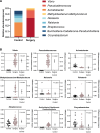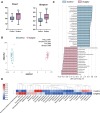Clinical Case-control Study of Postoperative Ocular Microbiota Colonization Using Microbial Analysis in Patients Undergoing Blepharoplasty
- PMID: 40529218
- PMCID: PMC12173316
- DOI: 10.1097/GOX.0000000000006876
Clinical Case-control Study of Postoperative Ocular Microbiota Colonization Using Microbial Analysis in Patients Undergoing Blepharoplasty
Abstract
Background: Blepharoplasty is the third most common plastic surgical procedure worldwide. However, its impact on the ocular surface microbiota remains unclear. This study aimed to investigate microbial changes before and after blepharoplasty.
Methods: A clinical case-control study was conducted involving 30 blepharoplasty patients and 23 controls. Ocular surface swabs were collected, and 16S rRNA sequencing was used to identify bacterial species and abundance. Bioinformatics analysis was performed to annotate and visualize microbial composition.
Results: Comparison between groups revealed that patients who underwent blepharoplasty had increased colonization by pathogenic bacteria, whereas controls were primarily colonized by neutral bacteria. Alpha diversity analysis showed a significantly higher bacterial abundance in the surgical group. Beta diversity analysis indicated significant differences in microbial community structure between the 2 groups. Subgroup analysis based on age and sex in the surgical group revealed no significant effects of these factors on microbial composition and abundance.
Conclusions: Blepharoplasty may disrupt the ocular mucosal barrier, altering the ocular microenvironment and promoting colonization by pathogenic bacteria. This microbial imbalance may contribute to postoperative ocular discomfort or dysfunction. Notably, age, sex, and surgery frequency did not influence the microbial profile in blepharoplasty patients.
Copyright © 2025 The Authors. Published by Wolters Kluwer Health, Inc. on behalf of The American Society of Plastic Surgeons.
Conflict of interest statement
The authors have no financial interest to declare in relation to the content of this article.
Figures




Similar articles
-
Return to Running After Achilles Tendon Repair: How Do US Navy Service Members' Physical Readiness Tests Change After Undergoing an Achilles Tendon Repair?Clin Orthop Relat Res. 2025 Jun 18. doi: 10.1097/CORR.0000000000003590. Online ahead of print. Clin Orthop Relat Res. 2025. PMID: 40536551
-
Molecular feature-based classification of retroperitoneal liposarcoma: a prospective cohort study.Elife. 2025 May 23;14:RP100887. doi: 10.7554/eLife.100887. Elife. 2025. PMID: 40407808 Free PMC article.
-
Integrating Gut Microbiome and Metabolomics with Magnetic Resonance Enterography to Advance Bowel Damage Prediction in Crohn's Disease.J Inflamm Res. 2025 Jun 11;18:7631-7649. doi: 10.2147/JIR.S524671. eCollection 2025. J Inflamm Res. 2025. PMID: 40535353 Free PMC article.
-
Radiation-induced injury and the gut microbiota: insights from a microbial perspective.Therap Adv Gastroenterol. 2025 Jun 16;18:17562848251347347. doi: 10.1177/17562848251347347. eCollection 2025. Therap Adv Gastroenterol. 2025. PMID: 40535532 Free PMC article. Review.
-
Prevalence and odds of anxiety and depression in cutaneous malignant melanoma: a proportional meta-analysis and regression.Br J Dermatol. 2024 Jun 20;191(1):24-35. doi: 10.1093/bjd/ljae011. Br J Dermatol. 2024. PMID: 38197404
References
-
- International Society of Aesthetic Plastic Surgery. ISAPS International survey on aesthetic/cosmetic procedures performed in 2022. 2023. Available at https://www.isaps.org.
-
- Codner MA, Kikkawa DO, Korn BS, et al. Blepharoplasty and brow lift. Plast Reconstr Surg. 2010;126:1e–17e. - PubMed
-
- Knize DM. Anatomic concepts for brow lift procedures. Plast Reconstr Surg. 2009;124:2118–2126. - PubMed
-
- Matarasso A, Hutchinson OH. Evaluating rejuvenation of the forehead and brow: an algorithm for selecting the appropriate technique. Plast Reconstr Surg. 2000;106:687–694; discussion 695. - PubMed
-
- Romo T, III, Zoumalan RA, Rafii BY. Current concepts in the management of the aging forehead in facial plastic surgery. Curr Opin Otolaryngol Head Neck Surg. 2010;18:272–277. - PubMed
LinkOut - more resources
Full Text Sources
